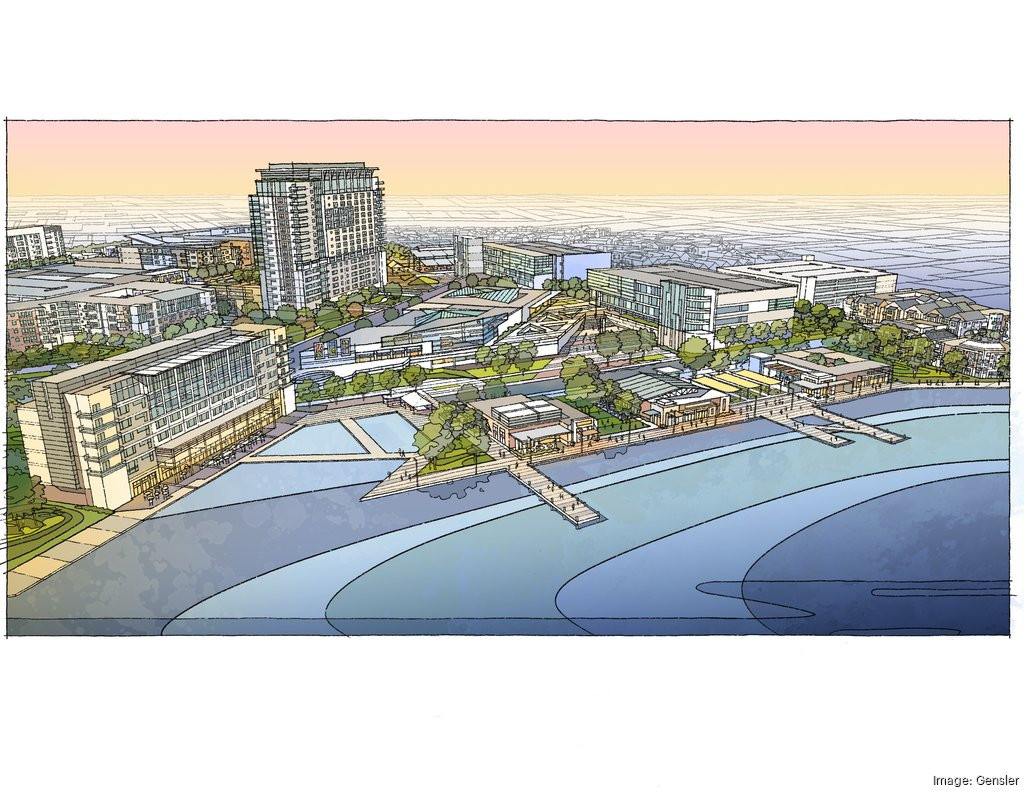
The longtime home of construction and engineering giant Fluor in Sugar Land could become a 53-acre mixed-use waterfront destination if one real estate firm’s plans come to fruition over the next several years.
Sugar Land-based Planned Community Developers said it had agreed to buy the 1.2 million-square-foot Fluor campus near Highway 6 and Highway 59 in Sugar Land, about 20 miles southwest of downtown Houston. Fluor plans to decamp for west Houston’s Energy Corridor by summer 2024.
PCD, developer of popular commercial sites such as Sugar Land Town Square and Lake Point Village Center, envisions transforming the 1980s-era office complex into a mixed-use destination overlooking Brooks Lake. Although plans are still in the early stages, the idea is to blend for-sale and rental residential space, a convention center and exhibition hall, a 4-star hotel, boutique office space and a bevy of restaurants and retail next to a boardwalk of walkable, connected piers jutting out into the lake. Plans call for walking trails and parks offering opportunities for kayaking, paddle boarding and more.
Architecture firm Gensler has been hired to help with the early stages of master planning for the project, which it’s calling Lake Pointe Plaza. On Tuesday PCD is to unveil more details about its plans a Sugar Land City Council workshop.
“As a developer, if you can find something that has water on both sides, you can have mature trees and you’ve got the city coming along saying ‘This is so important to the future,’ then you can do things differently," said Don Janssen, president of PCD. "It’s not just about dollars and cents; this is a critical piece of property.”
Fluor has had its offices at the lakefront site at 1 Fluor Daniel Drive since the 1980s, and this year announced plans to move 1,300 employees to the Energy Corridor by next June.
“It’s somewhat of an iconic setting because it’s one of the largest private sector campuses in the county,” said Jeffrey Wiley, president of the Fort Bend County Economic Development Council. The EDC subleases a small office on the campus from Fluor, Wiley said, and he expects the council to eventually relocate.
“It’s disappointing to have Fluor leave the community, but Fluor will do what it is has to do. This has given (the community) the opportunity to do something special with the tract over the coming years,” said Wiley, who is not involved with the redevelopment project.
Sugar Land is not offering any economic incentives tied to redevelopment of the project, a city spokesperson said, although that could change. The site would have to be rezoned to allow for dense, mixed-use development with offices, retail, hotels and apartments. The campus is within an area earmarked by the city as a so-called regional activity center where it wants to encourage dense office and residential uses.
Zoning restrictions and not-in-in-my-backyard attitudes among some residents have partially prevented the development of multifamily projects in much of Sugar Land over the years, real estate sources said, and the city has sought to change that by designating certain areas for more apartment development, including the Lake Pointe area and the future Imperial Char House redevelopment.
PCD expects its project to include apartments and other rental space, but the majority of the residential space would likely be for-sale homes at varying price points and age groups, including so-called middle market housing, Janssen said.
PCD already has secured an equity partner, but it is waiting to get approvals from the city on rezoning prior to closing on the property, he said. (Fluor sold the property years ago and has been leasing it from current owner Maxxam.) If all goes according to plan, PCD could secure construction financing and break ground on the Lake Pointe Plaza development by the third quarter of 2024, he said.
It’s likely the developer would demolish many of the 1980s-era buildings to build ground-up spaces, he said. Although an early conceptual rendering does depict a high-rise building, Janssen said, the heights, sizes and square footages of the buildings haven’t been finalized. A lot will depend on the market, and the development could take 10-15 years to build out, he said.